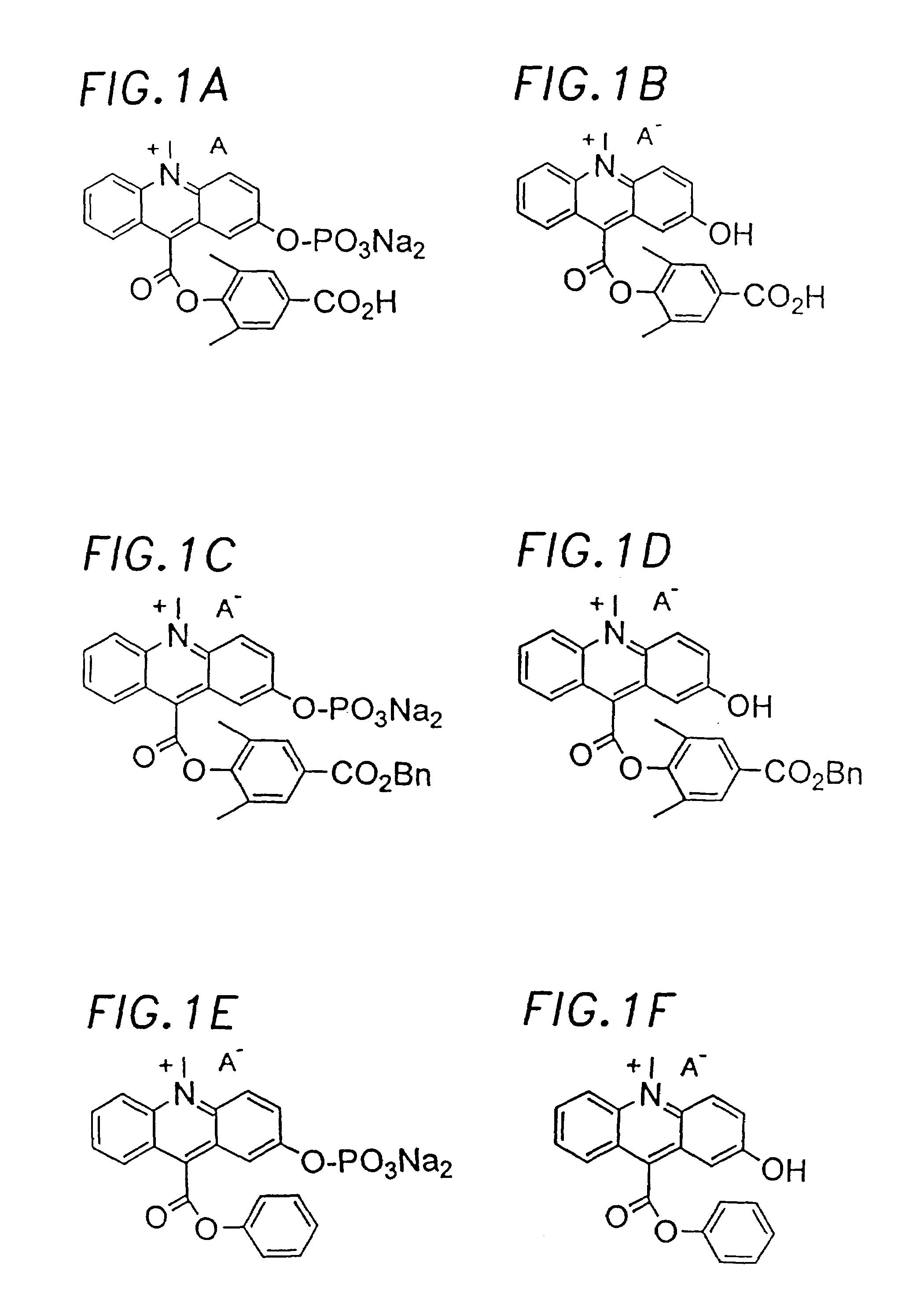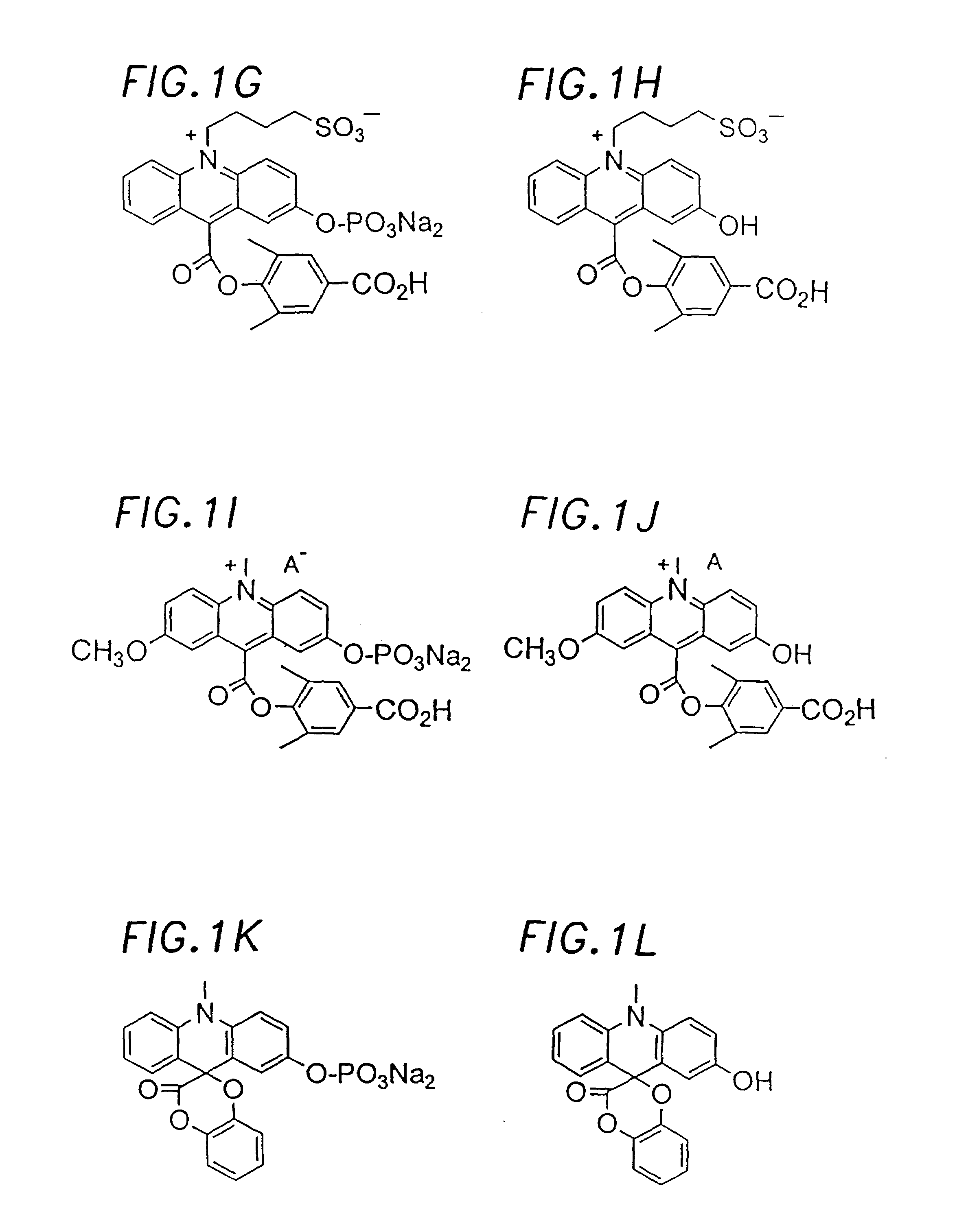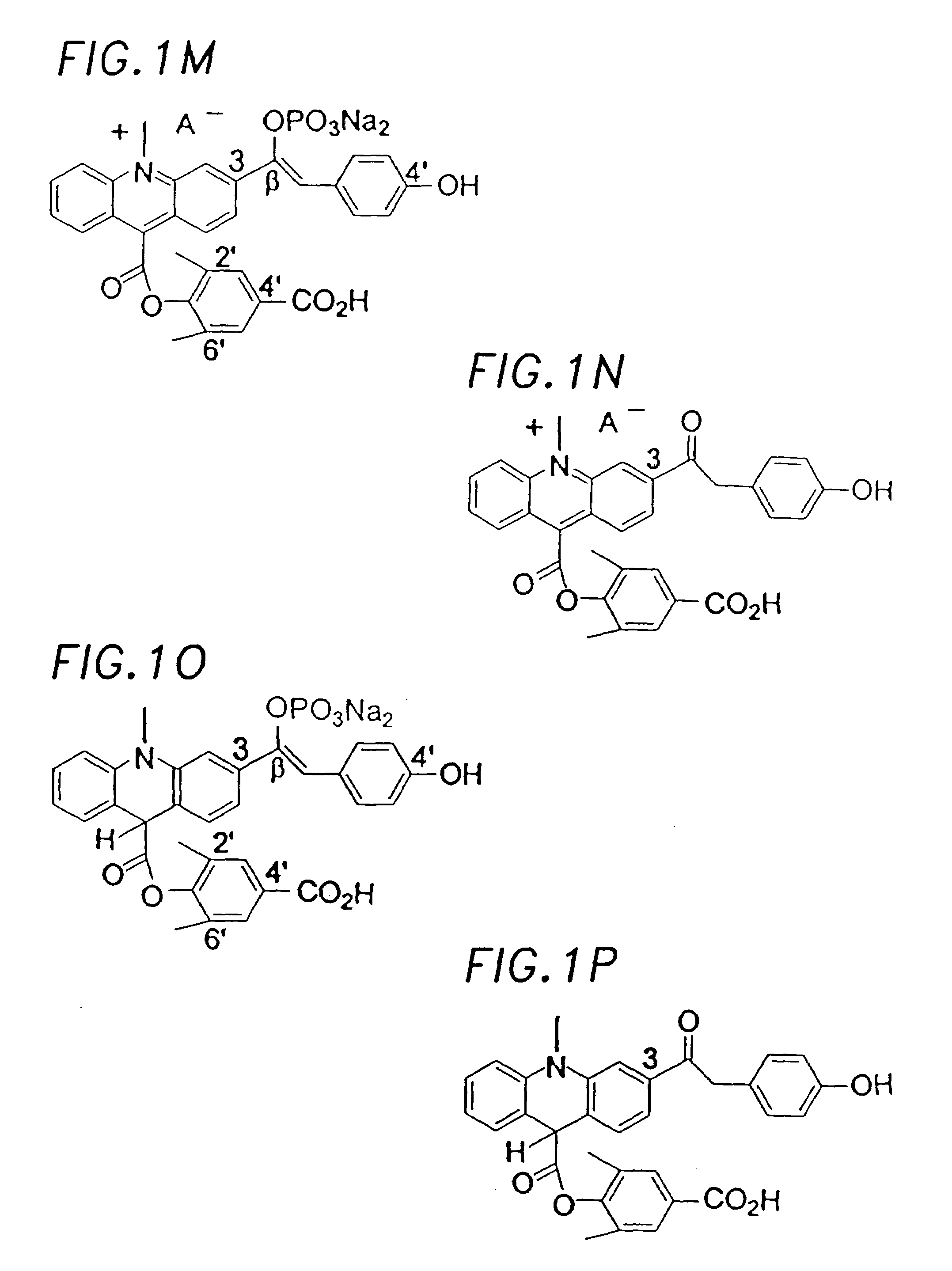Chemiluminescent acridinium compounds and analogues thereof as substrates of hydrolytic enzymes
a technology of acridinium compounds and hydrolysis enzymes, which is applied in the field of chemiluminescent compounds, can solve the problems of phenoxide, once generated by enzymatic reaction, and background chemiluminescence in the absence of enzymes, and achieves the effects of reducing light output, enhancing light output, and improving separation
- Summary
- Abstract
- Description
- Claims
- Application Information
AI Technical Summary
Benefits of technology
Problems solved by technology
Method used
Image
Examples
example 1
Synthesis of (2′,6′-dimethyl-4′-benzyl-oxycarbonyl)phenyl 2-hydroxy-10-methyl-acridinium-9-carboxylate trifluoroacetate (2-OH-DMAE-Bn, 4).
[0169]
4-Methoxyethoxymethoxy-iodobenzene
[0170]A solution of 4-iodophenol (10 g, 45.45 mmol) in 200 ml of anhydrous tetrahydrofuran was treated at 0° C. with sodium hydride (2.36 g, 60% dispersion, 59.09 mmol) for 5 minutes. To the resulting mixture, methoxyethoxymethyl chloride (8.3 ml, 72.73 mmol) was slowly added over a 5-minute period. The mixture was stirred at 0° C. under nitrogen for 30 minutes, warmed to room temperature, and stirred for 24 hours. The solvent was removed under reduced pressure. The residue was taken into 500 ml of ether, washed with 5% sodium hydroxide (4×200 ml), water (4×200 ml), saturated sodium chloride (1×200 ml), and dried over sodium sulfate. Evaporation of the solvent under reduced pressure gave an oily product in 14.1 g. TLC (silica gel, ether): Rf 0.5.
N-(4-Methoxyethoxymethoxy)phenyl isatin
[0171]A solution of isat...
example 2
Synthesis of (2′,6′-dimethyl-4′-benzyloxy-carbonyl)phenyl 2-phosphoryloxy-10-methyl-acridinium-9-carboxylate trifluoroacetate (2-Phos-DMAE-Bn, 3)
[0175]
[0176]A solution of (2′,6′-dimethyl-4′-benzyloxycarbonyl)phenyl 2-hydroxy-10-methyl-acridinium-9-carboxylate trifluoromethane-sulfonate (50 mg, 0.102 mmol) in pyridine (0.5 ml) was cooled to 0° C. and then added dropwise over a 3 minute period to a pre-cooled solution of phosphorous oxychloride (57 μl, 6 eq.) in 0.5 ml of pyridine. The reaction mixture was stirred at 0° C. under nitrogen for 30 minutes. The reaction was quenched with 400 μl of 0.5 N NaOH followed by another 200 μl of 1 N NaOH. The mixture was diluted with 1 ml of water, and then filtrated. The resulting yellow solid was dissolved in mixed DMF and water, and separated on a preparative HPLC column (YMC, 250×30 mm, ODS, 10 μm), eluted in gradient by mixing 0.05% TFA / water (solvent A) and 0.05% TAF / acetonitrile (solvent B) in the following manner: 30 to 60% B in 40 minute...
example 3
Synthesis of (2′,6′-dimethyl-4′-carboxyl)phenyl 2-hydroxy-10-methyl-acridinium-9-carboxylate trifluoroacetate (2-OH-DMAE, 2)
[0177]
[0178]A solution of (2′,6′-dimethyl-4′-benzyloxy-carbonyl)phenyl 2-hydroxy-10-methyl-acridinium-9-carboxylate trifluoromethanesulfonate (100 mg) in 4 ml of 30% hydrogen bromide in acetic acid was stirred at 55° C. under nitrogen for 1 hour, and then treated with 10 ml of anhydrous ether. The resulting precipitate was collected and washed with ether (4×10 ml) to give 80 mg of (4-carboxyl-2,6-dimethyl)phenyl 2-hydroxy-10-methyl-acridinium-9-carboxylate bromide. MS (ESI): m / z 402.7 (M+). 1H NMR (300 MHz, CD3CN / MeOD-d4): 52.52 (6H, s), 4.95 (3H, s), 7.78 (1H, d, J=2.7 Hz), 7.76 (2H, s), 8.10 (1H, t, J=7.0 Hz), 8.13 (1H, dd, J1=9.9 Hz, J3=2=2.7 Hz), 8.40 (1H, d t, J1=2.7 Hz, J2=8.0 Hz), 8.62 (1H, d, J=8.0 Hz), 8.77 (1H, d, J=9.2 Hz), and 8.78 (1H, d, J=9.9 Hz). The further purification of the above product (68 mg) was carried out by preparative HLPC (YMC, 250×...
PUM
| Property | Measurement | Unit |
|---|---|---|
| temperature | aaaaa | aaaaa |
| pH | aaaaa | aaaaa |
| quantum efficiency | aaaaa | aaaaa |
Abstract
Description
Claims
Application Information
 Login to View More
Login to View More - R&D
- Intellectual Property
- Life Sciences
- Materials
- Tech Scout
- Unparalleled Data Quality
- Higher Quality Content
- 60% Fewer Hallucinations
Browse by: Latest US Patents, China's latest patents, Technical Efficacy Thesaurus, Application Domain, Technology Topic, Popular Technical Reports.
© 2025 PatSnap. All rights reserved.Legal|Privacy policy|Modern Slavery Act Transparency Statement|Sitemap|About US| Contact US: help@patsnap.com



